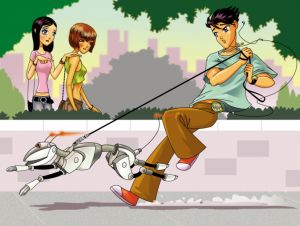
In January of 2015, a memorial service took place in Isumi, Japan, at a 450-year-old Buddhist temple. The figures being honored were brought together at the altar, where a priest offered prayers for the peaceful passing of their souls and for the deceased to be reunited with their owners. Owners? Well, yes, it turns out the funeral was orchestrated to say goodbye to a group of dogs whose owners had recently died. The dogs themselves were less dead, really, than broken. They were robots, or had been. That the dogs were mechanized in no way diminished the solemnity of the service for those attending.
Japanese Culture and Automation
Sony Corporation produced the AIBO robot dog from 1999-2006. The company discontinued its maintenance program for the beloved robot dogs in March of 2014. As in the animated film "Robots," people hunted for private repair shops that could salvage the dogs. In real life, such fix-it places are owned or run by former Sony technicians familiar with the technology, but parts may be scarce. People feel emotionally attached to their dogs, however, and figure out as best they can how to keep them alive for as long as possible. While this behavior may seem strange to someone in the United States, Americans may be able to relate through their attachments to their own flesh-and-blood canine friends. Attempting to repair the robot dogs may be akin to taking an old dog to the vet.
Religious Influences
The Western Judeo-Christian traditions generally separate the body from the soul and the mind. Eastern religious philosophies may take a different point of view that supports, or at least does not prevent, an emotional connection to a non-organic entity. For example:
- Tenets of Buddhism state that all beings may be devoid of selfhood and exist only through cause and condition.
- Shinto is an animist practice that acknowledges spiritual presence in all objects.
Loyalty Born on the Battlefield
Some observers say that the attitude the Japanese people take with the robots is a reflection of universal behavioral. A striking example may be the efforts U.S. soldiers have been shown to make toward protecting and salvaging robots designed to perform in combat. It is a case where the irony of the situation may hold the key to understanding it. The robots are built for dangerous jobs such as explosives retrieval and dismantling. They are intended to be sacrificed, if necessary, so that human soldiers may not be harmed. Soldiers are known, however, to rush damaged robots to a repair facility as if to the hospital. The robots fight side by side with U.S. troops, and soldiers have responded by treating them as their own, with memorials and even a 21-gun salute, an honor reserved for the much-esteemed.
Machines Imitating Life
The robots in the battlefield may little resemble Sony's adorable dogs, but they share some common traits. Both types of robots, to varying degrees, are physical objects that process information. Many people may believe that an emotional connection to an object may be the result of a human desire to anthropomorphize the non-human world, but others may disagree. Makoto Nishimura was a pioneer in robotics who said in 1928 that the objects that humans create are "nature's grandchildren." In other words, objects may be created by humans as humans are born of nature.
The AIBO robot dog funerals may be a way to honor a connection and its loss, just as in human memorials. When a soldier ceremoniously donates his or her purple heart to a combat robot, he or she may honor and celebrate the life force that went into creating such a thing. Robots may be more than man-made mechanisms. They are designed to respond, and in responding may forge an emotional bond between human and machine.
Add Your Comment